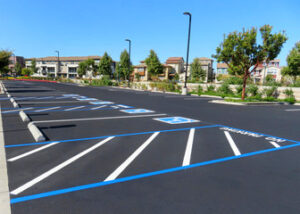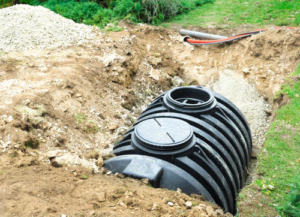Asphalt Sealcoating is a crucial part of the maintenance process for your parking lot. It provides a protective coating against UV rays, water, gasoline leaks and other oxidizing substances that cause asphalt to deteriorate over time.

It replenishes oils and gives faded asphalt a rich black finish that improves the look of your property and increases its value. Visit https://www.rochesternysealcoating.com/ to learn more.
Asphalt pavement is made from a mixture of aggregate, such as gravel and sand, mixed with petroleum-based binder. The binding agent is what makes the asphalt flexible and pliable enough to handle traffic loads and temperature fluctuations. However, the binder can deteriorate quickly when water, gas, and other chemicals come into contact with it. Seal coating prevents this from happening by creating a protective barrier for your asphalt.
Moreover, the asphalt surface is protected against the harmful UV rays of the sun. The dark colored material that is used for seal coating absorbs the UV rays and keeps your pavement from fading and getting dry. It also helps the asphalt last longer by keeping it pliable and fresh.
In addition, the seal coat acts as a barrier to chemical leaks that are common in parking lots and roadways. Motor oil and gasoline leaks are harmful to your asphalt because they will contaminate the petroleum binder, causing it to become brittle and prone to cracking and crumbling. When the asphalt is brittle, it can no longer handle the pressure of vehicles and will break apart from the bottom layer.
Before you can apply a new sealcoat, the old one must be properly cleaned to remove any dirt or debris that could interfere with the adhesion of the new coat. You can use a broom or brush to remove any loose dirt, moss, or other contaminants from the asphalt pavement. Also, it is important to repair any damaged or defective areas of your asphalt pavement prior to applying the sealcoat. Our best selling asphalt crack filler machines can help you do this job efficiently and effectively.
Enhances the Appearance
As asphalt ages, it can begin to fade in color. A regular sealcoating process can prevent this, preserving your pavement’s appearance. The asphalt surface looks refreshed and new when sealcoated, giving it a dark finish that boosts curb appeal. This is especially important for commercial properties looking to attract customers, as well as homeowners wishing to maintain or increase their property value.
Asphalt pavements are subject to damage from environmental factors, including water, sunlight, oil, and chemical spills. Over time, these elements can cause cracks, potholes, and other imperfections in the surface. Sealcoating protects these surfaces by creating a barrier that guards against oxidation, water penetration, and the freeze-thaw cycle. Sealcoating is an essential step in asphalt maintenance, helping to extend its lifespan and protect it from environmental damage.
Whether used as a driveway, parking lot, or other pavement surface, asphalt requires regular maintenance to keep it in top condition. Sealcoating is one of the most effective ways to preserve your paved surfaces, helping you avoid costly repairs and replacements in the future. This preventative maintenance can save you money on a large scale, making it an excellent investment in your property’s longevity.
Before applying a seal coat, it is crucial to power wash the surface and remove any oil spots or stains. This will ensure the application of a clean, uniform sealant. The proper equipment is also required to safely and effectively apply the sealant. This is an unruly job that involves handling liquid chemicals, and should only be performed by qualified professionals who understand the safety issues involved with working with these substances. Refined coal tar, which is an ingredient in many sealant formulations, creates fumes during drying that can pose health risks if workers are not properly outfitted and protected.
Prevents Water Damage
Water damage to asphalt is a serious problem that erodes the graded foundation that supports your pavement. Asphalt oxidizes under the sun, weakening it and leaving openings that allow moisture to penetrate the surface and degrade the underlying base. The result is cracking and sinking that eventually leads to potholes. Sealcoating prevents this degradation by protecting the asphalt from UV rays and minimizing moisture penetration.
Humidity is another factor that impacts the sealcoating process. The humidity level must be low for the material to dry. If the surface you need to be sealed is covered in fog, contractors will have to wait for it to clear before starting the project. The same goes for rain. Rain prevents the sealcoat from adhering to the underlying asphalt and can ruin your investment.
It’s essential that you block off areas where the sealcoating is applied until it dries completely. If you don’t, people will walk or drive on it and could dislodge the material, destroying all of your hard work. Ideally, you should have signs that warn people to stay off of the blacktop until it dries, as well.
Sealcoating also helps to prevent oil spills by creating an impermeable barrier on the asphalt. This layer keeps chemicals and oils from penetrating the underlying surface and allows you to remove these substances without damaging your pavement. This protection is especially important for commercial property owners, as these materials are a significant source of pollution and can be dangerous to people’s health. By keeping them from soaking into the pavement, you can protect your employees, visitors, and customers from these dangers. By taking these steps, you can ensure that your pavement lasts for as long as possible and avoid expensive repair costs.
Prevents Oil Spills
The asphalt used in pavement is a by-product of petroleum. Its chemical structure easily dissolves other products that are derived from petroleum such as gasoline, diesel fuel, motor oil and grease. When these substances seep onto your asphalt surface they penetrate into the lower layers of the paving and break down the asphalt binder that holds the aggregate together. This can cause the pavement to crumble, crack and eventually deteriorate. Sealcoating creates a barrier between these chemicals and your asphalt and protects the pavement from further damage.
Oil stains on your asphalt look unsightly, but even worse is the damage they can do to the pavement. The petrochemicals in the oils will dissolve the asphalt binder and destroy the base layer of your pavement. Sealcoating prevents these petrochemicals from penetrating the pavement and saving you money in repair costs.
While Sealcoating saves you money by preventing damage, it cannot fix existing chips or cracks in your pavement. These damages must be repaired by repaving or patching the area. Without addressing these damages they will become larger and require more costly repairs in the future. Sealcoating can prevent the deterioration of your pavement and extend the life of your investment.
Preparation and Application of the Sealant
Before a seal coating job can begin the surface needs to be thoroughly cleaned. This is done by power washing and/or scrubbing the area. This process can take a full day to complete. Then it must dry for 24 hours before vehicles can drive on the newly sealed surface.
Aside from cleaning the surface, workers must wear the proper personal protective equipment (PPE) while applying the sealant. This includes boots, face masks, gloves and safety glasses to prevent exposure to harmful particles and fumes.
Saves Money
Sealcoating may seem like an unnecessary expense but it is a financially prudent strategy that reduces the need for costly repairs. Studies show that for every dollar spent on asphalt maintenance, the owner saves $8 to $10 in repair costs down the road.
Over time, UV rays can cause your blacktop to fade from deep black to gray or brown. In addition, they deteriorate the asphalt surface and damage the aggregate underneath. Keeping the surface protected with a layer of sealant can slow this process and prolong the life of your pavement.
Cracks and potholes create tripping hazards that can cost your business money. Trips and falls lead to lawsuits and property damage. In addition, damaged surfaces make it difficult to determine safe areas for parking and traffic flow, increasing the risk of accidents and vehicle damage. Regular sealcoating protects your asphalt and reduces these risks, preventing expensive lawsuits.
Another way sealcoating saves you money is by preventing repaving. Without a protective layer of sealant, cracks and breaks will worsen over time, eventually requiring you to repave the entire area. Repaving costs between $1-$4 per square foot, so a small investment in sealcoating can save you a lot of money in the long run.
A well-maintained asphalt surface not only increases the value of your property, it also sends a message to customers and tenants that you are committed to keeping the premises in good condition. With professional sealcoating, you can extend the lifespan of your asphalt and improve its appearance with minimal effort.
